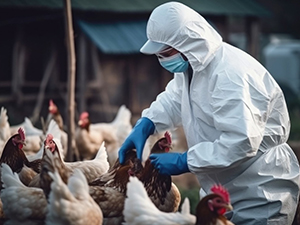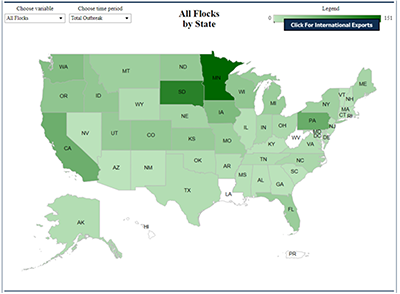Update on the Poultry & Avian Flu Outbreak: February 2024
Feb 6, 2024
The 2023-2024 winter flu season has seen a resurgence in bird flu aka Highly Pathogenic Avian Influenza (HPAI) H5N1 cases. With the panzootic flu strain reaching the end of its second full year and deaths still being regularly recorded in domestic flocks, wild birds, and mammals, producers and processors must consider long-term mitigation and management solutions to what may become an endemic strain.
Cases in Domestic Flocks
Farmers are still suffering as they try to protect their flocks while minimizing profit loss. With over 81 million birds affected since HPAI arrived in the U.S. in 2022 and 3.8 million birds affected in the last 30 days, this is an ongoing struggle without a clear resolution. HPAI has been found in commercial or backyard flocks in 47 states in the U.S. This winter, outbreaks have affected egg laying and meat flocks across the country:
- According to the January USDA Egg Market Report, egg inventory is down by an average of 10% across the country, with the Southwest region (which includes California) down by over 25%;
- In Kansas, new outbreaks in local gamebird producers as well as egg and meat productions are being reported weekly; and
- In Wisconsin, a meat turkey farm had 41,000 birds culled due to infection.
And while serious discussions regarding the viability of domestic poultry vaccination have commenced, no decision has been reached yet.

The last 30 days

Total outbreak
Cases in Wild Birds
Wild birds have been and remain a key transmitter of HPAI to domestic flocks. Wild bird cases of HPAI have been documented in all 50 states and mass mortality events are still occurring. Wildlife rehabilitation facilities have indicated that HPAI cases account for nearly half of all of their bird intakes. In recent months, species that have been affected by HPAI include but not limited to:
- Birds of prey, such as eagles, owls, and vultures;
- Gulls, terns, and pelicans; and
- Endangered species—21 California Condors, which makes up 6% of the wild population of the species, have perished.
While the number of wild cases may seem small compared to domestic flocks, it’s important to understand that very few wild birds are actually tested for HPAI; therefore, the numbers reflected in official statistics are likely undercounted. This means that the risk of HPAI transmission from wild birds to domestic flocks remains high.
Cases in Mammals
Unfortunately, domestic and wild birds are not the only animals being affected by HPAI. Mammals, too, are becoming infected, falling ill, and dying from HPAI, most likely by consuming infected birds. Affected species include, but are not limited to:
- Domestic mammals, such as pet cats and mink;
- Predators, such as coyotes, foxes, bobcats, and bears; and
- Other mammals, such as raccoons, opossum, skunks, and otters.
Every time HPAI spills over from birds to mammals there is concern the virus will mutate or merge with a mammalian strain of influenza and spread more easily between mammals. This possibility is especially worrisome for livestock operations, so it is necessary to continually protect facility health by deterring nuisance birds from production and processing properties.

Recommendations
This is an ongoing situation that Wild Goose Chase Indy is monitoring very carefully. To ensure continued biosecurity and the safety of domestic flocks, livestock, and domestic mammals, we recommend the following.
Domestic Flocks & Livestock
Continue implementing heightened biosecurity measures to protect egg-laying chickens, poultry, and livestock operations. As HPAI can be spread by wild birds, it is paramount to ensure they have as little presence on your property as possible; wild birds are often attracted to these properties because they reliably provide food and water sources. An automated laser system specifically designed to deter and manage nuisance wild birds can significantly reduce the risk of HPAI contamination at your production and processing facilities.
Domestic Mammals
Avoid feeding raw poultry or wild bird products to domestic pets. Prevent pets, especially bird hunting dogs, from ingesting any wild birds and limit their exposure to birds as much as possible. While it is likely that some pets have already become infected, small animal veterinarians are not testing for avian flu like wildlife officials are, so data is currently unavailable.
Keep Flocks Safe with Wild Goose Chase Indy
Since the 2014-2015 HPAI outbreak, Wild Goose Chase Indy has helped poultry farmers, egg producers, and livestock processing facilities maintain heightened biosecurity measures through the deployment of automated laser systems. To learn more about how automated lasers keep wild birds away from domestic flocks, or to schedule a site evaluation, contact us.



 0
0
